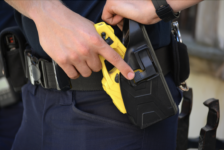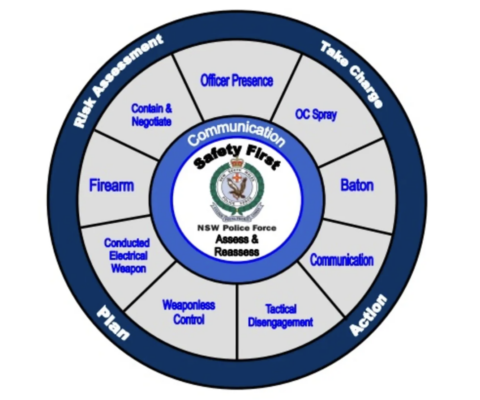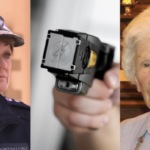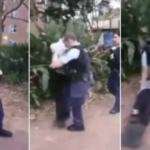In What Circumstances Can NSW Police Officers Discharge Tasers?

Australians are united in their outrage over the killing of 95-year-old great grandmother Clare Nowland, following her tasering by a senior constable of the New South Wales Police Force, Kristian White, at Yallambee Lodge aged care facility in Cooma.
Prosecutors are now considering whether to upgrade the officer’s charges of assault occasioning actual bodily harm, common assault and recklessly causing grievous bodily harm to murder or manslaughter following the death of Ms Nowland, who succumbed to injuries caused by the tasering, which including a fractured scull when she collapsed after being hit by the charge.
Here’s an outline of the rules prescribed by the New South Wales Police Force regarding the use of tasers.
What is a taser?
A taser, more accurately described as a conducted energy device, is a weapon designed to administer an electrical discharge on contact that will cause incapacitation or submission of a person.
The models of taser used by NSW Police are the Taser X26E and Taser X26P. A taser looks like a pistol and operates in a similar way in that a trigger is used to operate the weapon. A red laser sight helps the person firing the weapon to aim accurately.
Tasers can be utilised in three different modes:
- Draw and cover mode: where the taser is activated and pointed (but not fired) at a person.
- Probe mode: where the taser fires a cartridge of barbed projectile (darts) at a person. The darts are connected by fine, insulated copper wires and will deliver an electrical discharge through a series of short, repetitive electrical pulses. When fired correctly, the Taser will cause neuromuscular incapacitation in which the person loses control over their body and falls to the ground until the current stops.
- Drive-stun mode: where the taser is applied directly to the body of the person. It does not achieve neuromuscular incapacitation as the electricity acts only on a small area, but it does cause pain.
When discharged, a taser will run a “cycle” of electrical discharge, which generally lasts 5 seconds. If a person is not incapacitated via a single cycle, multiple cycles might be used.
General rules regarding use of tasers
Section 230 of the Law Enforcement (Powers and Responsibilities) Act 2002 (LEPRA) sets out that police officers have the the power to use force only when it is ‘reasonably necessary’ in exercising their legal functions.
Section 231 of the Act, makes it clear that this includes when making an arrest.
Anything beyond what is reasonable is considered to be an assault under the law.
What constitutes a “reasonable” level of force can be difficult to determine, but should be limited to what is necessary to restrain. This means if you were to resist arrest, more force could be use, but if you are otherwise compliant any use of force should be kept to a minimum.
The NSW Police Operation guidelines on Use of Conducted Electrical Weapons (Taser) outline when and how tasers should be used by NSW Police.
The guidelines make it clear that tasers should only be utilised in draw and cover mode after first assessing the situation and concluding circumstances dictate the drawing of a taser. The guidelines further state that police should continue to assess the environment and the situation unfolding before them and where the reason/justification for drawing the Taser ceases to exist, the Taser should be deactivated and re-holstered.
According to the guidelines as taser must only be discharged (in either probe or drive-stun mode) in order to:
- Protect human life.
- Protect yourself or others where violence confrontation or violent resistance is occurring or is imminent.
- Protect and officer in danger of being overpowers or to protect themselves or another person from the risk of actual bodily harm.
- Protect themselves or others from animals
Police should only use force that is reasonable, necessary, proportionate and appropriate to the circumstances. Police should also use no more force than is reasonably necessary for the safe and effective performance of their duties.
A police officer must consider the Tactical Options Model (provided below) in determining whether a taser is the most appropriate use of force in the situation, or whether other options are available.
Use of Tasers Against Vulnerable People
The NSW Police Operation guidelines provide restrictions on the use of tasers for certain vulnerable groups, including the elderly.
The guidelines state that a taser should not be used unless exceptional circumstances exist on:
- A person who is handcuffed.
- Females where it is suspected on reasonable grounds they are pregnant.
- Elderly or disabled people.
- A child or person of particularly small body mass.
Exceptions circumstances are defined in the guidelines as meaning “circumstances that would cause a reasonable person to believe that prompt and unusual action is necessary to prevent actual bodily harm to self or others”.
Further restrictions
The NSW Police Operation guidelines further note that a taser should not be used:
- For an investigative purpose other than protection or to facilitate an arrest.
- Near explosive materials, flammable liquids or gasses due to the possibility of ignition
- On persons where there is a likelihood of significant secondary injuries (concussive brain injury) for example: a fall from an elevated position.
- Punitively for the purposes of coercion or as a prod to make a person move.
- Against passive non-compliant subjects who are exhibiting non-threatening behaviour.
- To rouse an unconscious, impaired or intoxicated subject.
- To target known pre-existing injury areas of a subject.
- As a crowd control measure, such as for crowd dispersal at a demonstration or industrial dispute.
- When the subject is holding a firearm
- Against a mental health patient solely to make them comply or submit to medication or treatment.
- Unless it is in the performance of the officers duties or at an approved weapons training day.
Finally, a taser may only be used in exceptional circumstances:
- Against the occupant(s) of a vehicle or the operator of machinery where there is a danger of the vehicle or machinery becoming out of control and posing a risk to occupants or bystanders.
- Against a subject who is fleeing.
- In Drive Stun mode for pain compliance.
- For a prolonged fashion by holding the trigger down for a period greater than five seconds.






